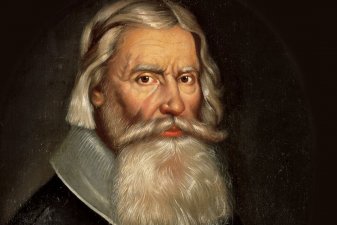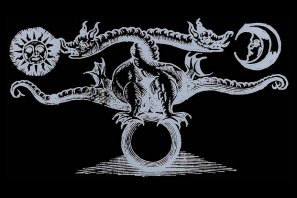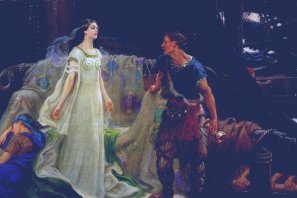In the annals of Northern Europe during the Renaissance, amidst the flourishing of Hermeticism, Kabbalah, and Medieval magic, emerges an intriguing figure whose life and work spanned the realms of pre-Christian mythology and esoteric Renaissance knowledge. Johannes Thomae Agrivillensis Bureus, known simply as Johannes Bureus (1568-1652), embodies this unique fusion of disparate yet intertwined traditions. Despite the scarcity of information about him, his contributions to the study of Nordic mythology and runology, alongside his engagement...
Everything on Mythology and related to the Maier files series. Posts, Articles referring to myths, mythology, ancestral tales, folklore, gods and goddesses
The rich tapestry of human history is often woven with the delicate threads of symbolism and tradition. One such fascinating journey takes us into the ancestral cult of flowers, exploring the deep meanings associated with these blossoms across various cultures and epochs. Among the myriad flowers that have captured the human imagination, the Mayan Nicte and the Rose stand out as emblematic figures in the ancestral tapestry of flora. In Mayan culture, the Nicte, a...
In the rich tapestry of Old Norse literature, tales of encounters between Christian kings and the remnants of the old gods persist as fascinating narratives that reflect the complex interplay between the pagan past and the emerging Christian present. One such tale unfolds in the saga of Óláfs Saga Helga, captured vividly in the introductory quote. ‘Have you no desire to be like that king who was victorious against all whom he fought,who was handsome also, and accomplished in all […]...
The exploration of ancient symbols often reveals hidden threads connecting diverse cultures. In the Maier Files Chronicles, we delve into the higher meaning of the swastika, tracing its roots through various traditions and shedding light on its symbolism beyond conventional interpretations. Herman Wirth’s research on the Ur-Nordic races in Germany serves as a guiding beacon, unraveling the swastika’s significance in a broader, universal context. The Hyperborean Race: Unveiling the Nordic Origin Wirth’s groundbreaking work challenges...
The School of Gnosticism was divided into two major parts, commonly called the Syrian Cult and the Alexandrian Cult. These schools agreed in essentials, but the latter division was more inclined to be pantheistic, while the former was dualistic. While the Syrian cult was largely Simonian, the Alexandrian School was the outgrowth of the philosophical deductions of a clever Egyptian Christian, Basilides by name, who claimed to have received his instructions from the Apostle Matthew. Like Simon...
The date of the founding of the Odinic Mysteries is uncertain, some writers declaring that they were established in the first century before Christ; others, the first century after Christ. Robert Macoy, 33°, gives the following description of their origin: “It appears from the northern chronicles that in the first century of the Christian Era, Sigge, the chief of the Aser, an Asiatic tribe, emigrated from the Caspian sea and the Caucasus into northern Europe. He directed his course northwesterly from […]...
The nornir or norns were a group of female supernatural beings closely related to ideas about fate in Old Norse tradition. Karen Bek-Pedersen provides a thorough understanding of the role played by norns and other beings like them in the relevant sources. Although they are well known, even to people who have only a superficial knowledge of Old Norse mythology, this is the first detailed discussion of the norns to be published amongst the literature...
The hidden Pagan history of Europe, the persistence of its native religion in various forms from ancient times right up to the present day. Most people today are more familiar with native traditions from outside Europe than with their own spiritual heritage. The Native American tradition, the tribal religions of Africa, the sophistication of Hindu belief and practice and the more recently revived Japanese tradition, Shinto, are widely acknowledged as the authentic native animistic traditions...
Popular culture has carved a deep impression of faeries as gentle, benevolent, and adorable creatures, like the bumbling trio from Sleeping Beauty or the precocious Tinker Bell. Glittery, spritely, generally of good nature, and existing solely to help mortals: this is how most modern people understand faeries. Traditional faery lore, however, paints a very different picture. Faery lore is deeply tied to the spirituality of the Celtic world, particularly in Ireland, where the human relationship to faeries has historically been a […]...
Intimacy. In our culture, there is an excessive concentration on the notion of relationship. People talk incessantly about relationships. It is a constant theme on television, film, and in the media. Technology and media are not uniting the world. They pretend to provide a world that is internetted, but in reality, all they deliver is a simulated world of shadows. Accordingly, they make our human world more anonymous and lonely. In a world where the...
Who’s Odin? To find Odin’s origins, how far back must we go? Although the most likely explanation for Snorri’s attempts to connect the Æsir with Troy is medieval literary fashion, it is tempting to see a possible source in folk memories of the migration of the Yamnaya culture from the steppes of the Caucasus and Urals into northern Europe four or five thousand years ago. Shaman Is Odin a shaman? Grundy and other critics of...
In Celtic Scotland there exist plenty traditions of sacred locations, places and folklore about people crossing into the Otherworld, a number of which are identified with sorcha (pronounced “sahkhaa”). This is an ancient phrase that means both ‘paradise’ and ‘illuminated being.’ Once again there’s a similarity with Egypt. Because the syllable ka is their word for ‘risen soul or awareness.’ Sidh Chailleann is the core of Scottish Otherworld tradition. This mountain marks the geodetic center of the country. The name […]...













